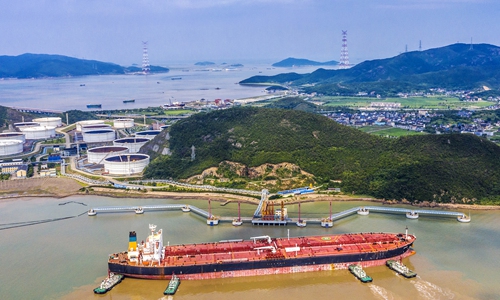HOME >> SOURCE
The Delta dazzles foreign markets
Source:Xinhua-Global Times Published: 2019/12/16 17:23:39
Shanghai and the provinces along the Yangtze River exude China’s fast-forward opening-up

A view of a port in Zhoushan, East China's Zhejiang Province in August Photo: cnsphoto
The Yangtze River Delta, one of China's most economically invigorating and innovative regions, has pressed the fast-forward button to open up to the world as the Chinese government recently devised a blueprint for further regional integration.Over the past few weeks, meetings were held in follow-up of a master plan for the Yangtze River Delta's integrated development unveiled on December 1 by China's top authorities.
The implementation of the plan is a major strategic measure to lead high-quality development and improve the planning of further reform and opening up, in a bid to build a strong and vibrant growth pole for development, said Luo Wen, vice head of the National Development and Reform Commission, China's economic planner.
The 358,000-square-kilometer expanse, about the same size as Germany, encompasses the provinces of East China's Jiangsu, Zhejiang and Anhui provinces as well as Shanghai. It contributes about one-fourth of the country's GDP and one-third of foreign trade and investment.
As a national strategy, the integrated development of the Yangtze River Delta region coordinates with the development of the Beijing-Tianjin-Hebei region, the Guangdong-Hong Kong-Macao Greater Bay Area, as well as the Belt and Road Initiative, said Zhang Xueliang, a professor at the Shanghai University of Finance and Economics.
All rivers flow seaward
Nestled in the Yangtze estuary with crisscrossing rivers, the region, led by Shanghai, has witnessed its residents enjoy geographical proximity and cultural affinity, as well as long-term exchanges with the outside world for a long time.
The Old Bund of Ningbo in Zhejiang was forcibly opened to trade in the 1840s, with colonizers from Britain, the US, France and other countries settling there more than a century ago.
But today, an independent China has led the Ningbo Zhoushan Port to become the largest port in the world in terms of cargo tonnage, linking the Yangtze River Economic Belt with the 21st Century Maritime Silk Road. It handled over 1 billion tons of cargo in 2018.
Less than 200 kilometers southwest of Ningbo is the country's small commodity hub of Yiwu, home to 15,000 foreign merchants from more than 100 countries.
Dubbed as the "world's supermarket," it receives more than 550,000 overseas buyers, and sells commodities to more than 210 countries and regions every year.
Gopher Chocolate, a Zhejiang-based enterprise, is just about to open a store in the Shanghai Hongqiao World Center, the first in the city.
At a Zhejiangadministrative approval service center, Mo Xuefeng, general manager of Gopher Chocolate (Shanghai) Co, received his business license, together with a license for food production and trading, both issued by market regulation authorities in Shanghai.
"With more relaxed administrative barriers, I saved a lot of legal work," Mo said.
Foreign businesses also enjoyed the convenience brought by regional integration.
Air Products and Chemicals Inc., a US-based industrial gas company rooted in the Yangtze River Delta region for more than two decades, was pleasantly surprised to find that governments within the region are competing with each other to improve the business environment and provide better administrative services.
Feng Yan, vice president of the company's subsidiary in China, used to feel that each government in the Yangtze River Delta had its own policies.
"But now they learn from each other and reached out to us first," Feng said.
A parlor for the world
With a lower threshold for market access, the free flow of talent and more business-friendly measures, the Yangtze River Delta region is turning into a meeting hall for global investors.
"Obviously, it's one of the most important partners for Czech companies and for the Czech Republic," said Richard Krpac, consul general of the Czech Republic in Shanghai, who also noted that more than 100 Czech companies have already invested in the region.
By hosting more than 130 international conferences last year, the region topped the list among China's three major city clusters, according to data from the International Congress and Convention Association.
Shanghai and Hangzhou became the second and third hottest destination cities in China for international conferences, with 82 and 28 meetings held in 2018 respectively.
Li Wei, vice director of the Yangtze River Delta and Yangtze River Economic Belt Research Center under the Shanghai Academy of Social Sciences, said the region is quickening its pace of operation as a functional platform for the interconnection and integration of global elements and resources.
"We saw a lot of new products, technologies and services make their debuts in Shanghai at the China International Import Expo (CIIE)," Li said, noting that the CIIE has become a platform to promote global multilateral trade.
The trade mission of the Yangtze River Delta region was a shining star during the second CIIE held in November, with more than 40,000 purchasers from Zhejiang making orders worth nearly 10 billion yuan ($ 1.43 billion).
The Yangtze River Delta cities, represented by Shanghai, Hangzhou and Nanjing, are gateways of the Asian-Pacific region and showcase China's opening up, said Yang Xiangdong, vice head of the Zhejiang-based Yangtze Delta Region Institute of Tsinghua University.
He also noted the region enjoys exceptional advantages such as a solid industrial foundation, China's huge domestic market and the country's reform and opening-up policies.
"As the Yangtze River Delta further integrates, a world-class city cluster is on the rise," Yang said.